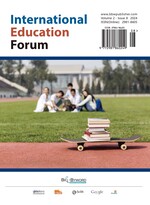Abstract
This study aims to explore the impact of the Rain Classroom platform on teachers’ workload and efficiency in college English classrooms. Through semi-structured interviews and classroom observations with several university English teachers who have used Rain Classroom, the findings indicate that while the platform reduces certain repetitive tasks and enhances classroom interaction efficiency, it also increases the technological learning and operational burden on teachers. The study provides valuable theoretical and practical insights for the effective application of educational technology in language teaching.
References
Li J, Xie Y, 2022, Exploring the Impact of Digital Learning Platforms on Teaching Effectiveness: The Case of Rain Classroom. Journal of Modern Education Review, 12(2): 122–138.
Zhou P, Liu H, Huang J, 2021, Analyzing the Impact of Rain Classroom on Teachers’ Workload and Instructional Practices in Chinese Universities. International Journal of Educational Technology in Higher Education, 18(2): 87–103.
Chen X, Liu Y, Zhang H, 2023, Challenges and Opportunities in Adopting Digital Teaching Tools in Higher Education: A Case Study of Rain Classroom. Journal of Educational Technology Development, 39(3): 56–72.
Wang M, Zhao L, 2022, The Role of Rain Classroom in Enhancing Learning Motivation and Classroom Engagement in College English Teaching. Language Learning & Technology, 26(1): 55–70.
Zhang Q, Li M, 2020, Integrating Technology in Language Teaching: Teachers’ Perceptions and Challenges. Journal of Second Language Teaching & Research, 9(1): 45–58.
Liu Z, 2021, Digital Teaching Tools in Language Education: A Critical Review. Journal of Modern Language Teaching, 28(2): 99–115.
Bates AW, Sangrà A, 2011, Managing Technology in Higher Education: Strategies for Transforming Teaching and Learning. Jossey-Bass, San Francisco.
Graham CR, 2013. Emerging Practice and Research in Blended Learning. In Handbook of Distance Education (3rd ed), Routledge, 2013: 333–350.
Garrison DR, Vaughan ND, 2008, Blended Learning in Higher Education: Framework, Principles, and Guidelines. Jossey-Bass, San Francisco.
Koehler MJ, Mishra P, 2009, What Is Technological Pedagogical Content Knowledge? Contemporary Issues in Technology and Teacher Education, 9(1): 60–70.
Selwyn N, 2016, Education and Technology: Key Issues and Debates (2nd ed.). Bloomsbury Publishing, New York.
Wang Y, Zhang X, Chen Z, 2020, Real-time Data Analytics in Educational Technology: Applications and Challenges in Higher Education. Journal of Educational Computing Research, 58(6): 1213–1231.
Liu Y, Xu L, 2021, Enhancing Student Engagement in Language Learning through Interactive Digital Platforms: A Study on Rain Classroom. Journal of Language Teaching and Research, 11(4): 213–229.
Richards JC, Rodgers TS, 2014, Approaches and Methods in Language Teaching (3rd ed.). Cambridge University Press, Cambridge.
Davis FD, 1989, Perceived Usefulness, Perceived Ease of Use, and User Acceptance of Information Technology. MIS Quarterly, 13(3): 319–340.
Teo T, 2011, Factors Influencing Teachers’ Intention to use Technology: Model Development and Test. Computers & Education, 57(4): 2432–2440.
Rogers EM, 2003, Diffusion of Innovations (5th ed.). Free Press, New York.
Zhao Y, Cziko GA, 2001, Teacher Adoption of Technology: A Perceptual Control Theory Perspective. Journal of Technology and Teacher Education, 9(1): 5–30.
